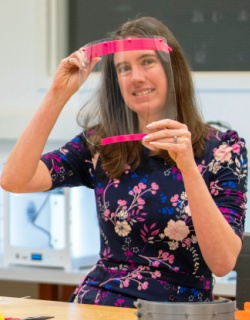

Photo credit: UVic Photo Services
Professor of Biomedical Engineering
University of Victoria
As the COVID-19 pandemic spread to North America in early 2020, concerns over shortages of personal protective equipment grew as the demand for such equipment skyrocketed among frontline workers.
University of Victoria engineering professor Stephanie Willerth jumped into action to respond to the increase in demand. Willerth holds a Canada Research Chair in Biomedical Engineering, and is Acting Director of the Centre for Biomedical Research. She repurposed the 3D printers in her biomedical lab to produce parts for face shields.
“We currently are producing around 8,000 face shields to distribute to Island Health and other doctors all across Vancouver Island,” Willerth explains. “I also am supervising the University of Victoria's biomedical engineering response to COVID-19. I have a team of 16, including 14 co-op students from a variety of disciplines working on projects to help with the COVID-19 pandemic.”
Her work is part of a collaborative effort between the university, local industry, and government to fight the pandemic.
“I have been in close contact with our colleagues at Island Health throughout the pandemic to better understand their needs,” she says.
Local individuals and companies have also contributed to the effort by donating time, equipment, and materials, or using the open-source designs and their own 3D printers to produce shields and other protective equipment. For example, Coast Capital Savings has donated $10,000 to support the initiative, Foreman CNC Machining is laser cutting the transparent shields, and some of the elasticized straps have been donated by community partners on Salt Spring Island. The components are all dropped in a bin outside of Willerth’s lab, where her team then inspects, assembles, sterilizes, and packages them for distribution.
This project is just one of many pandemic-related projects Willerth is working on. She’s also collaborating with a civil engineering colleague to monitor COVID-19 levels in wastewater. These projects, she says, are just two examples of the many ways engineers are contributing to pandemic response.
“Engineers, and in particular biomedical engineers, are stepping up to help address the issues stemming from the pandemic,” Willerth explains. “The pandemic has illustrated certain limitations inherent in the current healthcare system. Biomedical engineers are currently working to address some of these deficiencies and hopefully, we will be better prepared for the next pandemic.”
Photo credit: UVic Photo Services

